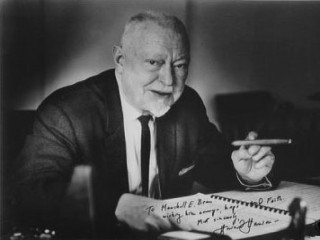
Howard Hanson biography
Date of birth : 1896-10-28
Date of death : 1981-02-26
Birthplace : Wahoo, Nebraska, U.S.
Nationality : American
Category : Famous Figures
Last modified : 2011-06-22
Credited as : Conductor and composer, music theorist, Metropolitan Opera in New York
Howard Hanson was born in October 1896 in Wahoo, Nebraska. He graduated from the Luther Academy and College in Nebraska in 1912, then studied under Percy Goetschius at the Institute of Musical Arts (later the Juilliard School) in New York City and under Arne Oldberg at Northwestern University in Evanston, IIIinois. In 1916 Hanson became an instructor at the College of the Pacific in California. His teaching and administrative talents soon became evident, and in 1919 he was made dean of the College of Music at the age of 23.
Hanson received an American Prix de Rome in 1921 and spent the next two years in Rome. His most important compositions in this period were the Nordic Symphony and The Song of Beowulf for chorus and orchestra, works which show his sober and highly expressive musical personality. Throughout his career, Hanson's compositions reflected the strong influence of the Finnish composer Jean Sibelius.
Among Hanson's significant compositions are an opera, Merry Mount, commissioned in 1934 by the Metropolitan Opera in New York, and seven Symphonies, of which the Third, the Romantic Symphony is perhaps the best known. In 1943 he received a Pulitzer Prize for his Fourth Symphony, Requiem. His Seventh Symphony was first performed in 1977. Other works include a Piano Concerto, Three Songs from Drum Taps and The Song of Democracy for chorus and orchestra, Concerto for Organ, Strings, and Harp, and the New Land, New Covenant, an oratorio for chorus, two soloists, orchestra, and narrator, commissioned for the 1976 Bicentennial.
In 1924, the founder of Eastman Kodak Company, George Eastman, asked Hanson to became director of the new Eastman School of Music in Rochester, N.Y. Hanson accepted and held the post until his retirement in 1964. His energy and administrative skill made the Eastman School one of the most important conservatories in America.
Hanson became active in several national musical organizations. He was one of the founders, and later the president, of the National Association of Schools of Music, whose main purpose was to raise the standards of university and conservatory musical training. He also served as president of the Music Teachers' National Association, as a director of the Music Educators' National Conference, and as musical consultant to the U.S. State Department. One of Hanson's most significant achievements was the 1925 founding of the annual Festival of American Music, which featured the works of many American composers of all styles. In an era when European composers still dominated the music world, these festivals established the important fact that America had produced a large group of talented composers. In 1976, Hanson himself donated $100,000 to support the program.
















